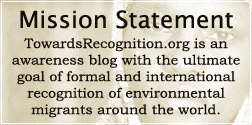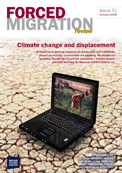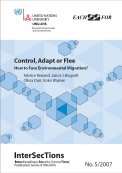Oxford’s Refugee Studies Centre shed some light on climate change and displacement from a local legal and policy framework perspective at a December 8 High Commissioner’s Dialogue side event. The Centre analyzed four countries that are particularly vulnerable to climate change-induced displacement: Bangladesh, Ghana, Kenya, and Bangladesh.
The study fills a significant lacuna. It assesses how legal protection frameworks might:
- mediate the impacts of displacement on people compelled to move because of environmental change;
- assist
in supporting strategies of adaptation and resilience for those at risk of displacement; and
- guide governments in devising relocation policies for people who live in the most vulnerable locations.
Although difficult to generalise from four case studies, the study provides a systematic review of the application and appropriateness of current frameworks, and how they might be adapted to this emerging category of migrants.
The case studies offer a cross-section of environmental conditions, internal and international displacement, slow-onset climate change scenarios – rising sea levels (Vietnam and Bangladesh) and desertification (Kenya and Ghana) – legal and normative rights protection apparatus, and governance structures.
The report finds that:
- Increasing internal political tensions created by environmental displacement reinforce the need to strengthen human rights protection;
- Protection for vulnerable groups before and after displacement, and in relation to slow-onset environmental displacement is significantly weak;
- Civil society actors are limited in playing an active role;
- Mixed migration flows and cross-border displacement are an increasing source of tension between governments, host communities and displaced persons;
- State-managed relocation policies to reduce vulnerability lack effective safeguards protecting the rights of relocated communities, are open to abuse and are rarely
transparent.
Read the report “Protecting environmentally displaced people: Developing the capacity of legal and normative frameworks” in full here.



